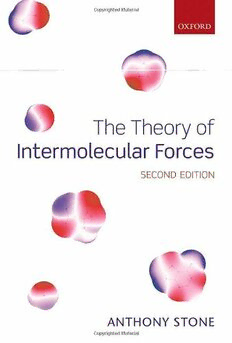
The Theory of Intermolecular Forces PDF
Preview The Theory of Intermolecular Forces
The Theory of Intermolecular Forces This page intentionally left blank The Theory of Intermolecular Forces Second Edition Anthony J. Stone University of Cambridge 1 3 GreatClarendonStreet,Oxford,ox26dp, UnitedKingdom OxfordUniversityPressisadepartmentoftheUniversityofOxford. ItfurtherstheUniversity’sobjectiveofexcellenceinresearch,scholarship, andeducationbypublishingworldwide.Oxfordisaregisteredtrademarkof OxfordUniversityPressintheUKandincertainothercountries ©AnthonyJ.Stone2013 Themoralrightsoftheauthorhavebeenasserted FirstEditionpublishedin1996 SecondEditionpublishedin2013 Impression:1 Allrightsreserved.Nopartofthispublicationmaybereproduced,storedin aretrievalsystem,ortransmitted,inanyformorbyanymeans,withoutthe priorpermissioninwritingofOxfordUniversityPress,orasexpresslypermitted bylaw,bylicenceorundertermsagreedwiththeappropriatereprographics rightsorganization.Enquiriesconcerningreproductionoutsidethescopeofthe aboveshouldbesenttotheRightsDepartment,OxfordUniversityPress,atthe addressabove Youmustnotcirculatethisworkinanyotherform andyoumustimposethissameconditiononanyacquirer BritishLibraryCataloguinginPublicationData Dataavailable ISBN 978–0–19–967239–4 Printedandboundby CPIGroup(UK)Ltd,Croydon,CR04YY LinkstothirdpartywebsitesareprovidedbyOxfordingoodfaithand forinformationonly.Oxforddisclaimsanyresponsibilityforthematerials containedinanythirdpartywebsitereferencedinthiswork. ToSybil Preface Thelasttwodecadeshaveseenconsiderableadvancesintheunderstandingofintermolecular forces,inthecomputationalmethodsusedtocalculatethem,andintheexperimentalmethods usedtoinvestigatethem.Atthetimeofthefirstedition,thebalancewasalreadyshiftingfrom experiment to computation as the prime source of information about intermolecular forces, and this shift has continued. Experiment will continue to have an essential role, but its task now is more to check the validity of calculations and to refine calculated potentials, rather thantoprovidetheprincipalsourceofdataforthem.DensityFunctionalTheoryhasemerged as a practical tool both for supermolecule calculations, when supplemented by an empirical dispersion term, and as a basis for perturbation theory. It has become possible to calculate interactions between molecules of 20 or 30 atoms to good accuracy, and methods are being developedtodescribelargermolecules,forexampletobuildproteinsfromanunderstanding of their component amino acids. The main changes in this new edition concern these devel- opments.Someissuesthatwerecontroversialinthe1990shavebeenresolvedandnolonger needdetaileddiscussion,andsomemethodshavebeensupersededandhavebeenmentioned morebrieflyoromitted. My own understanding has benefited greatly from several years’ enjoyable and fruitful collaborationwithDrAlstonMisquitta,andIamgladtobeabletoacknowledgehisconsid- erable contribution. I am indebted both to him and to Professor Sally Price for reading and commentingondraftsofthisnewedition. The book is intended to be self-contained as far as the theory of intermolecular forces is concerned. It does assume a sound background in physics, chemistry and mathematics, and in particular in quantum mechanics, but appendices are provided to introduce some of the mathematical techniques. The level of the book is appropriate for graduate students and advancedundergraduates,butitshouldalsobeusefulformoreexperiencedresearchworkers whorequireanintroductiontothefield. While I have tried to ensure that this edition is free from errors, it is possible that some will have crept through. Any that are found will be reported on my website at http://www- stone.ch.cam.ac.uk/timf.html. Cambridge A.J.S. June2012 Preface to the first edition Therehavebeenmanydevelopmentsinthetheoryofintermolecularforcesoverthelasttwenty years or so that have not so far been collected together in book form. After many years of effort,practicalmethodshaveemergedfortheaccuratecalculationofintermolecularinterac- tionsbyperturbationtheory.Increasingcomputerpowerismakingitpossibletopensionoff theLennard-Jonespotentialafter75yearsofvaluableserviceandtousemorerealisticmod- Preface vii els; similarly point-charge models are giving way to more sophisticated multipole descrip- tions. This has come at a time when experimental methods for determining intermolecular potentials are becoming more and more powerful and reliable, and when interest in accu- ratemodelsofintermolecularinteractionsisgreaterthaneverbefore,notleastbecauseofthe increasing use of computer modelling for simulating systems of biological interest and for designingbiologicallyactivemoleculesforuseasdrugsandpesticidesandthelike. However, these more elaborate descriptions call for corresponding developments in the formalism.Themathematicalexpressionsforinteractionenergiesinvolvingelectrostaticmul- tipoles, for instance, are daunting for the beginner, but they can be expressed in a relatively simpleformwithappropriatemathematicaltechniques.Forcesandtorquesarisingfromthese interactions can also be manipulated much more easily than is often supposed. I have been interested in these techniques for some time, and I have attempted in this book to set them outinacoherentfashion.Thecalculationofintermolecularinteractionsabinitioandthecon- structionofaccuratepotentialmodelsarecloselyrelatedtopicsthatIhavedescribedinsome detail.Thedeterminationofintermolecularpotentialsfromexperiment,ontheotherhand,is notanissuethatIhaveattemptedtocoverindetail,andIhavegivenonlyanoutlineofthis aspectofthesubjecttoputthetheoryincontext,togetherwithreferencestofulleraccounts. Itisapleasuretoacknowledgethecontributionsofmyresearchstudentsandpost-doctoral researchassistantstotheideasdescribedhere,especiallythoseofSallyPriceandDavidWales, with whom I have had many stimulating discussions and rewarding collaborations in recent years. I thank all my colleagues in the theoretical chemistry group at Cambridge for their supportandencouragement;manyofthemhavereadpartsofthetextindraftandmademany helpful suggestions. David Buckingham, Nicholas Handy, Ruth Lynden-Bell, David Clary and Roger Amos have all been most agreeable and stimulating people to work with. It is a particular pleasure, as he approaches retirement, to acknowledge the enormous contribution madebyDavidBuckinghamtothestudyofmolecularpropertiesandintermolecularforces. I am grateful also to Paul Hoang and Claude Girardet for their hospitality at the Universite´ deFrancheComte´ inBesanc¸on,whereIwasVisitingProfessorforatimein1993andwhere thefirstdraftofthis bookwaswritten.IthankBillMeath formuchvaluableadviceandfor permissiontoreproduceFig.8.2.Manyothershavecontributedinvariousways;itwouldbe invidious to name a few and impossible to list everyone, but I am grateful to all of them. It goeswithoutsaying,butitmustbesaid,thatallerrorsthatremainaremyresponsibilityalone. This book was prepared using LATEX and BibTEX with the natbib bibliography package, makeindex and hyperref. I am glad to acknowledge the generosity of the TEX community worldwideinmakingtheirprogramsfreelyavailabletoall. Cambridge A.J.S. December1995 This page intentionally left blank Contents 1 Introduction 1 1.1 Theevidenceforintermolecularforces 1 1.2 Classificationofintermolecularforces 4 1.3 Potentialenergysurfaces 6 1.4 Coordinatesystems 8 2 MoleculesinElectricFields 13 2.1 Molecularproperties:multipolemoments 13 2.2 Theenergyofamoleculeinanon-uniformelectricfield 21 2.3 Polarizabilities 24 2.4 Hyperpolarizabilities 30 2.5 Theresponsetooscillatingelectricfields 31 2.6 Symmetrypropertiesofmultipolemomentsandpolarizabilities 34 2.7 Changeoforigin 39 3 ElectrostaticInteractionsbetweenMolecules 43 3.1 Theelectricfieldofamolecule 43 3.2 Multipoleexpansionincartesianform 45 3.3 Sphericaltensorformulation 47 3.4 Examples 52 4 PerturbationTheoryofIntermolecularForcesatLongRange 57 4.1 Introduction 57 4.2 Theinductionenergy 59 4.3 Thedispersionenergy 64 5 AbInitioMethods 74 5.1 Introduction 74 5.2 Electroncorrelation 75 5.3 Densityfunctionaltheory 78 5.4 Basissets 79 5.5 Calculationofmolecularproperties 83 5.6 Thesupermoleculemethod 87 5.7 Densityfunctionaltheoryforinteractionenergies 92 5.8 Semi-empiricalmethods 95 5.9 Potentialenergysurfaces 95 5.10 Energydecompositionanalysis 96 6 PerturbationTheoryofIntermolecularForcesatShortRange 100 6.1 Introduction 100 6.2 Symmetricperturbationmethods 106
